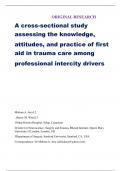ORIGINAL RESEARCH
A cross-sectional study
assessing the knowledge,
attitudes, and practice of first
aid in trauma care among
professional intercity drivers
Mokom A. Awa1,2
, Sherry M. Wren2,3
1Ndop District Hospital, Ndop, Cameroon
2Centre for Neuroscience, Surgery and Trauma, Blizard Institute, Queen Mary
University of London, London, UK
3Department of Surgery, Stanford University, Stanford, CA, USA
Correspondence: Dr Mokom A. Awa (alfredawa@yahoo.com)
,© 2021 M.A. Awa & S.M. Wren. This open access article is licensed under a
Creative Commons Attribution 4.0 International License
(http://creativecommons.org/licenses/by/4.0/),
which permits unrestricted use, distribution, and reproduction in any medium,
provided you give appropriate credit to the original author(s) and the source,
provide a
link to the Creative Commons license, and indicate if changes were made.
East Cent Afr J Surg. 2021;26(1):15-21
https://doi.org/10.4314/ecajs.v26i1.3
Abstract
Background
First aid (FA) provided by trained layperson first responders to individuals injured
in road traffic accidents has been shown to im-
prove injury outcomes, especially in resource-limited settings. This study aimed to
assess the knowledge, attitude, and practice
of FA provided to injured individuals among professional intercity drivers in the
North-West Region of Cameroon (NWRC) and to
identify barriers that may impede effective delivery of FA by these drivers.
Methods
Using a cross-sectional study design, we conducted interviews regarding the
knowledge, attitudes, and practices of FA in a con-
venience sample of 600 professional intercity drivers in the NWRC in February
2018. Interviews were done using a context-appro-
priate, structured questionnaire. In each section, questions were scored as 1, 0.5, or
0 for correct (or positive), partially correct, and
incorrect (or negative) responses, respectively. Total scores in each section were
scaled to a range of 0 to 10. Mean scores were
obtained for drivers’ knowledge, attitudes, and practice of FA. Analyses included
paired-samples t tests and multinomial regression.
,Results
We enrolled 589 drivers; the mean age of drivers was 38 years. In total, 107
(18.2%) had prior training in FA, and most drivers (83.2%)
received FA training while in driving school. The mean scores for knowledge and
practice were significantly lower than the mean
score for attitude (P<0.001). FA kit possession was significantly associated with
prior provision of FA to individuals injured in road
traffic accidents (OR, 2.32; 95% CI, 1.61-3.34). Almost all drivers (95.9%) agreed
that provision of FA improves injury outcomes, and
90% of them were willing to attend workshops on FA training.
Conclusions
FA knowledge and practice among professional intercity drivers in the NWRC is
inadequate despite high scores for attitude to-
wards FA. Training workshops on FA and the integration of basic FA training into
driving school curricula may improve FA knowl-
edge among professional intercity drivers in Cameroon.
Keywords: first aid, road traffic injury, professional drivers, Cameroon
Introduction
M
ost low- and middle-income countries (LMICs) have
limited emergency medical services (EMS) and pre-
hospital trauma care in both urban and rural areas. In these
resource-limited settings, trained laypersons who provide
first aid (FA) may improve trauma outcomes.[1]-[4] This
journal.cosecsa.org
has been demonstrated in a layperson FA responders pro-
gramme implemented in South Africa.[5] However, FA is
, frequently not administered or administered incorrectly.
A systematic review from 2012 reported that only 10.7%
to 67% of people with traumatic injuries received FA, and
83.7% of FA was administered incorrectly.[6] These findings
EAST and CENTRAL AFRICAN Journal of Surgery | VOLUME 26 | NUMBER 1
| JAN-MAR 2021
15
Original Research
North-West Region, Cameroon: First aid by professional intercity drivers
highlight the need to understand the knowledge, skills, and
technical elements that are required to successfully imple-
ment community-based FA responder programmes.
At the time of this report, Cameroon’s EMS, Service d’Aide
Médicale d’Urgence (SAMU), was limited to the country’s
2 largest cities of Yaoundé and Douala, with plans in place
to extend SAMU to the main cities in all 10 regions of the
country. However, SAMU does not always function effec-
tively and has poor coverage of emergency prehospital care
in Yaoundé.[7] A low percentage of patients with traumatic
injuries are transported to health facilities by ambulances
(<3%-62%) as per studies carried out in Yaoundé.[8],[9]
In Douala, transport of injured patients is often delayed
(the average time to arrival at hospital is 75 min).[10] The
North-West Region of Cameroon (NWRC) has a popula-
tion of over 2 million and has no EMS. One study reported
that, in the NWRC, patients with traumatic injuries were




